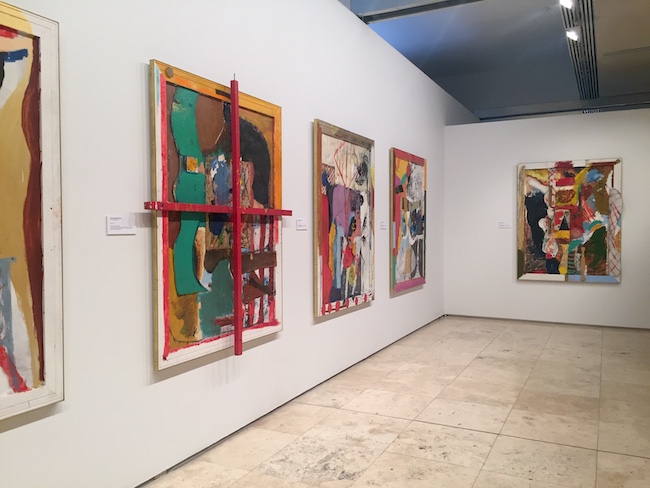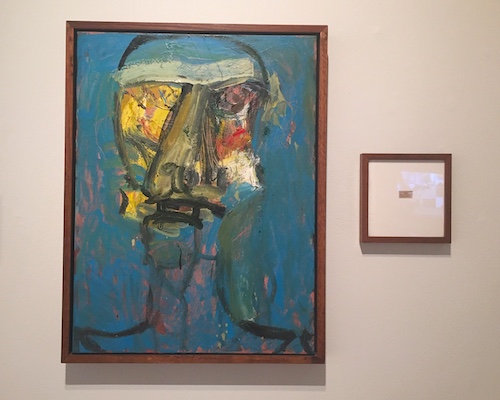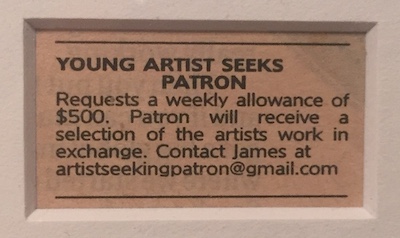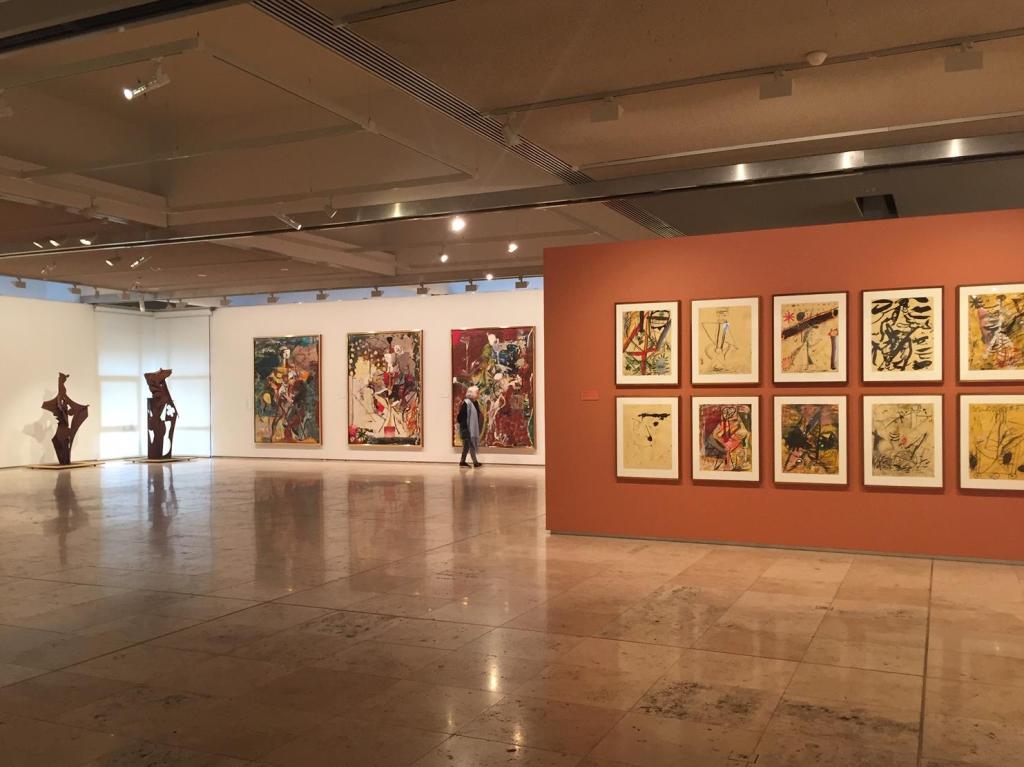Installation view James Drinkwater: The sea calls me by name, Newcastle Art Gallery (2019); photo ArtsHub.
In a video recorded on the making of his art, Novocastrian artist James Drinkwater recalls the words of painter Fred Williams. ‘When asked what he thinks about when he is painting, he said he is thinking about every other picture he’s looked at. “That is something Bonnard would do; there’s a bit of Olsen there … Oh Whiteley would do that”. That is [also] what I am thinking about.
‘What painting is for me is this long, eternal conversation with the past,’ said Drinkwater.
That very sense of a slippery thread that connects across time, across location, moments and memories is palpable to the viewer when stepping in to Drinkwater’s major solo exhibition, The sea calls me by name, presented by Newcastle Art Gallery (NAG).
Scanning this huge survey of 80 works that confidently move between grand abstractions, grungy constructions, lofty bronzes, and wall-mounted ceramics, you find yourself adopting Williams’ words.
Echoes of art history feel familiar and, yet they remain illusive; the work is not didactic or derivative, and the realisation settles that Drinkwater is a unique talent.
NAG has been collecting Drinkwater’s work since 2012: the first was a work painting made during a short but intense stay in Kenya (2012) with his partner, artist Lottie Consalvo. The most recent is dedicated to their son Vincenzo, and captures a mental shift in the work, bringing it back home to Newcastle and family.
While not sitting in direct sight lines of each other, they bookend a video that shows Drinkwater making assemblages on the streets of Kenya and Berlin, where he lived for three years (2009-2012).
It captures what can only be described as an incredibly free, gestural and exuberant process of making, total void of any self-conscious vacillation. He described: ‘It is like setting off on a voyage and you strap yourself to the mast and just get going.’

Installation view suite of paintings from the VMI series (2017), James Drinkwater: the sea calls me by name Newcastle Art Gallery (2019); photo ArtsHub
Perhaps it is this lack of hesitation that, as viewers, we pick up on in the gallery space. One can easily join the connections between object and canvas, sculpture and collage – their gestural layers one and the same despite the choice of medium.
I found myself thinking in the space that the paintings are so sculptural and the sculptures so painterly. For some artists this is such a departure, but for Drinkwater it is a natural oscillation – heck it has no division.
The beauty of this exhibition is that regardless of how globally travelled Drinkwater is (one can rattle off the shopping list of jaunts in Paris, London, Tahiti, Kenya, Germany) the show emanates from a place of home: Newcastle.
On the title wall of the exhibition hangs a painting of the same title as the exhibition, painted last year. It comes from the recent series Looking for urchins and Louis Ferrari (2018), where memories of searching rockpools with his children, and that of his grandfather Captain Louis Ferra, an Italian doctor who served in Hiroshima, meld and fuse.
To its right is one of Drinkwater’s earliest paintings Poor Boy, made in 2009 when Drinkwater was living in Melbourne post art school and was playing in a rock band. It was also when he met Consalvo, and the two made a pact, ‘that they would be artists, no matter what’.
‘I’m eternally looking back on that time, because it was so definitive,’ he told The Herald. It hangs next to a clipping from the newspaper classifieds which Drinkwater posted at the same time, “Artist Seeking Patron”.


Installation view Poor Boy (2009), Newcastle Art Gallery (2019), with detail of newspaper classified; photo ArtsHub
In both of these, across that decade-long divide, Drinkwater’s identification as an artist is paramount to his work. Anne Ryan, curator Australian Art, Art Gallery of NSW, describes Drinkwater a ‘romantic’.
‘His work is empathetic and emotionally resonant, with feeling being its most consistent and powerful driver. Places take on powerful significance … his work is about intimacy; relationships between people and place are open and exposed as the private is make public,’ she writes in the exhibition catalogue.
There is a lot in this exhibition; not just in the volume of work presented, but its incredible density and reach. From a monumental sculpture made from old industrial parts from a Newcastle factory that pays a nod to Robert Klippel; ceramics that capture the spirit of live and the hand of John Olsen; to pavement-assembled arts in Berlin, or a suite of imposing abstractions framed by the same framer as Brett Whiteley, it is all there and more.
Drinkwater said, ‘What I like about memory is that it is wonderfully inaccurate … when we reflect on it, it becomes tangible and malleable like clay … I play with memory in that way.’
There is that beautiful resonance of coming home in the exhibition; that familial connection and understanding that heritage and lineage are the important foundations that underpin what drives us – a constant flow of looking back and looking forward.

The sea calls me by name is an exhibition that allows the viewer to find their own journey within. Newcastle Art Gallery is the fitting destination venue for this show – it has the largest holdings of Drinkwater’s work in a public institution, but also captures that sense of legacy and support of local artists.
Everything is a two-way street, and this exhibition demonstrates that beautifully.
5 stars out of 5 ★★★★★
James Drinkwater: the sea calls me by name
1 June – 11 August 2019
Newcastle Art Gallery





